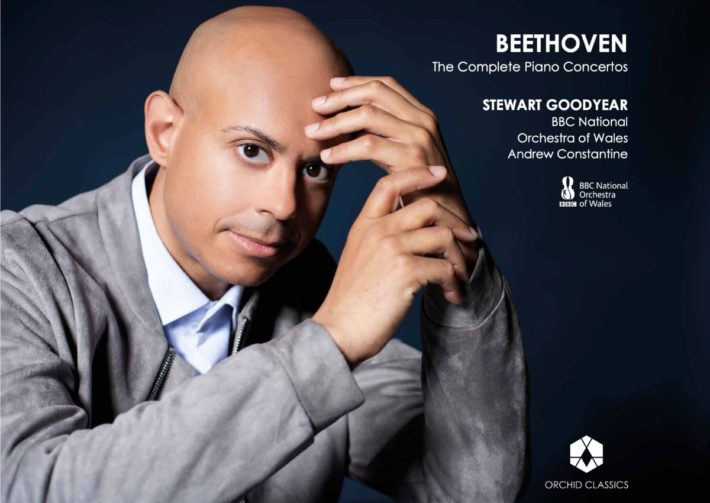Stewart Goodyear has built a respectable catalog of recordings, which include cornerstones of the piano repertoire. Already having committed the complete Beethoven piano sonatas, he now turns his attention to the concertos, with conductor Andrew Constantine and the BBC National Orchestra of Wales.
There is an overall consistency of style and interpretative choices with Goodyear’s Sonatas cycle; The performances are direct, technically assured and played with clear conviction. this is not to say that this style will suit all tastes, nor the Concertos’. The opening movements of each of Concertos No. 1-3 are appropriately paced. The orchestral tuttis of concertos one and two adhere to Beethoven’s markings, but are rather plain in their execution. The range of expression to bring these to life is missing, overlooking the youthful wit, with the use of contrasting dynamics and off-beat accents. In the Third Concerto, the darker nature of Beethoven’s beloved C minor is not fully realized by neither pianist nor conductor, in contrast to, say, Lars Vogt with the Royal Northern Sinfonia or Paul Lewis with the BBC Symphony Orchestra, both more intense, even foreboding
The slow movements of these three Concertos are marginally more successful. Goodyear is much more relaxed and finds beauty in the First Concerto, although lacking the hushed serenity of Mitsuko Uchida. The Adagio of the Second Concerto is overly brisk in its execution, and the “Largo” of the Third Concerto is faithful to the score, but misses the intensity of emotion bellied in this music. Here I wished for phrasing that highlights the musical peaks needed to bring this intensity to the fore.
The three Rondos of Concertos 1-3, while aptly paced, all suffer the same uniformity of approach, especially taking into account the lack of distinction on each repeat. The “Allegro Scherzando” of No. 1 lacks excitement, both pianist and conductor feel slightly disjointed. Martha Argerich and Seiji Ozawa show what can be done here when conductor and pianist really unite. The Finale of No. 2 (marked “Molto Allegro”) is very precise, but feels rather self-constricted. The sforzandos — a key aspect of Beethoven’s early style, are under-executed and lack distinction. Boris Giltburg with Vasily Petrenko and the Royal Liverpool Philharmonic Orchestra offer a more exciting performance, and as we’ve pointed out in our review, provide one of the most successful Op. 19 in recent memory. Giltburg’s tone — not dissimilar to Goodyear’s, has a greater range of color which tempers the instrument’s upper register with warmth. The Finale of the Third Concerto misses contrasting colors, making the whole experience rather monochromatic.
Related Classical Music Reviews
- Review: Beethoven – Piano Concertos (Complete) – Jan Lisiecki
- Review: Beethoven – Piano Concerto No. 1 and 2 – Giltburg
- Review: Beethoven – Complete Symphonies – Vienna Philharmonic Orchestra – Nelsons
The chords that open Piano Concerto No. 4 can bring magic when voiced with insight or allowed to grow organically. Uchida makes the opening feel like the beginning of a journey, whereas Goodyear is very matter of fact. His left-hand is executed with caution throughout, making some of the arpeggios and chords — another feature of Beethoven’s distinctive piano writing, become almost insignificant. While his playing throughout is well-articulated, the nuances of tone are sadly lacking. This is not helped by the dry orchestral accompaniment and a rather close recording, which gives the piano significant prominence over the orchestra and prevents us from hearing more shades of tonal color. The no-nonsense approach to the central slow movement creates a sense of struggle between the orchestra and pianist, but misses the authority Uchida finds.
The “Emperor” concerto needs the biggest range of pianistic colors. Pierre-Laurent Aimard, Stephen Kovacevich and Paul Lewis, with their respective conductors and orchestras, are all remarkably successful. Leif Ove Andsnes, conducting from the keyboard, presents a comparable approach to Goodyear’s in this Concerto, but commands a greater tonal spectrum. Goodyear’s sound is compromised on occasions in the grander moments of the first movement, lacking richness and sonority in the lighter passages. The slow movement is executed well, but lacks the poetry Lewis expresses. Though It’s difficult not to find exuberance in the last movement – Goodyear finally letting go of the reigns in what is the most successful movement of this cycle. Here, his brightness of tone feels completely appropriate, finding the home it has been searching for.
All in all, these are very straightforward performances from Goodyear and Constantine, that will best satisfy those who liked the pianist’s full Sonatas cycle. Recorded over 10 days in September 2018, the performances are solid and secure, but lacking the refinement found in many other complete cycles. The uniformity in Goodyear’s tone and approach is clearly appreciated, but the similarity, consistency of color and plainness of phrasing across the five concertos make this cycle stand in the shadow of many towering Beethovenians.

Beethoven – Piano Concerto No. 1-5
Stewart Goodyear – Piano
BBC National Orchestra of Wales
Andrew Constantine – Conductor
Orchid Classics, CD ORC100127
Beethoven Piano Concertos – Recommended Comparisons
Read more classical music reviews or visit The Classic Review Amazon store
Follow Us and Comment:
[wd_hustle id=”HustlePostEmbed” type=”embedded”]











